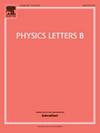Electromagnetic leptogenesis with light-heavy sterile neutrinos
IF 4.3
2区 物理与天体物理
Q1 ASTRONOMY & ASTROPHYSICS
引用次数: 0
Abstract
We propose a novel leptogenesis scenario utilising the two-body decay of heavy right handed neutrino (RHN) via the electromagnetic dipole operator. While the requirement of the standard model (SM) gauge invariance requires such dipole operator only at dimension-6 forcing the generation of non-zero CP asymmetry from three-body decay with two-loop corrections, we write down dimension-5 dipole operators involving heavy RHN and its lighter counterpart . This allows the generation of lepton asymmetry in from two-body decay of heavy RHN which later gets transferred to left handed leptons via sizeable Yukawa coupling with a neutrinophilic Higgs doublet. The asymmetry in left handed leptons is then converted to baryon asymmetry via electroweak sphalerons. The lepton number violation by heavy RHN also induces a one-loop Majorana mass of rendering the light neutrinos to be Majorana fermions. While smallness of the Majorana mass of prevents additional sources or washout of lepton asymmetry, it also constrains the scale of leptogenesis. Sub-GeV sterile neutrinos, depending upon their masses come with interesting implications for low energy experiments, neutrino oscillation, warm dark matter as well as effective relativistic degrees of freedom. Additionally, heavy RHN can lead to observable monochromatic photon signatures at terrestrial experiments.
用轻而重的无菌中微子进行电磁致瘦
我们通过电磁偶极子算子提出了一种利用重右手中微子(RHN)的两体衰变的新的轻生情景。标准模型(SM)规范不变性要求只有在6维时才需要这样的偶极子算子,这迫使具有双环修正的三体衰变产生非零CP不对称,我们写出了涉及重RHN NR及其轻对应的νR的5维偶极子算子。这使得重RHN的两体衰变在νR中产生轻子不对称,然后通过与嗜中微子希格斯双重态的相当大的汤川耦合转移到左手轻子。左手轻子的不对称性通过电弱闪子转化为重子的不对称性。重RHN对轻子数的破坏也导致了一个马约拉纳质量为νR的单环,使得轻中微子成为马约拉纳费米子。虽然νR的马约拉纳质量较小可以防止额外的源或轻子不对称性的冲洗,但它也限制了轻子发生的规模。gev以下的无菌中微子,取决于它们的质量,对低能实验、中微子振荡、热暗物质以及有效的相对论自由度都有有趣的影响。此外,重RHN可以导致在地面实验中观察到单色光子特征。
本文章由计算机程序翻译,如有差异,请以英文原文为准。
求助全文
约1分钟内获得全文
求助全文
来源期刊

Physics Letters B
物理-物理:综合
CiteScore
9.10
自引率
6.80%
发文量
647
审稿时长
3 months
期刊介绍:
Physics Letters B ensures the rapid publication of important new results in particle physics, nuclear physics and cosmology. Specialized editors are responsible for contributions in experimental nuclear physics, theoretical nuclear physics, experimental high-energy physics, theoretical high-energy physics, and astrophysics.
 求助内容:
求助内容: 应助结果提醒方式:
应助结果提醒方式:


